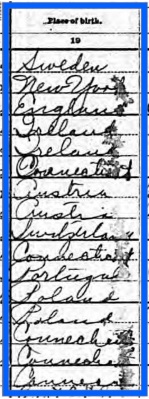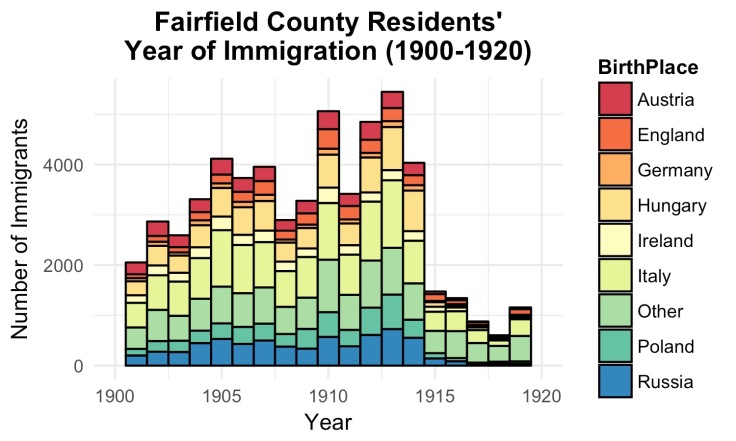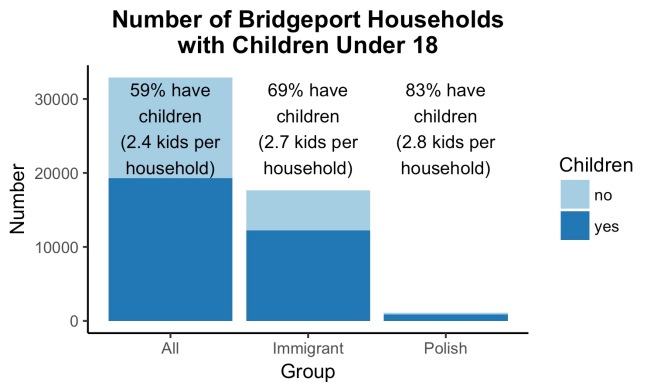It’s amazing the information available in the many of the U.S. censuses. For example, on just part of a census page from the 1920 census in Bridgeport, Fairfield County, Connecticut (showing my husband’s great-grandfather, Blazej Sochocki [Suchocki], and family), we can learn much more than just that a given family lived in a particular town:1



Of course we see details of the family members – Blazej listed (age 42) with his wife Victoria (maybe 37?), daughter Josephine (age 6), son Joseph (age 4 or 5), and daughter Wanda (age 2).
By also looking at information provided for other households nearby, we can learn more about the neighborhood where the family lived. While Blazej and Victoria were both born in Poland and their children were born in Connecticut, they had neighbors born both other places in the United States, and throughout Europe, including Sweden, England, Ireland, Austria, Switzerland, and Portugal – seemingly a fairly diverse community.

Similarly, looking at occupations of neighbors can give additional insight into how the family might have interacted with those around them. Blazej was listed as a truckman in a factory. That’s a somewhat vague workplace, but looking at some of his neighbors, we see that an awful lot of them also worked in a factory. There’s no guarantee that they all worked in the same factory, but this many people in one neighborhood all working in a factory could be indicative of a factory very nearby where many (if not all) of them worked.
It’s clearly helpful to look beyond a given family’s census entries to get some sense of their surroundings, but looking at a handful of families at a time gives a limited perspective on the community they lived in.
Luckily, it is possible to analyze the census data in larger chunks than can be done by scanning the pages line-by-line. This can help answer questions that are both grander in scope than a single census page, yet can also be specific to what we’re interested in.
Census data for large-scale analyses
IPUMS-USA (the Integrated Public Use Microdata Series) has census data freely available for all censuses from 1850-2010 (excluding 1890) – including FULL CENSUS DATA for the 1850, 1880, 1900, 1910, 1920, 1930, and 1940 censuses. These datasets are de-identified (meaning we can’t find any person in the census by name), but we can sort, subset, average, and otherwise examine these incredible datasets.
Community composition
To get a feel for the whole population of Bridgeport City and Fairfield County, I downloaded data from the 1920 100% Population Database, for people from the State of Connecticut.2 I then filtered the data (in R) to only include records for Fairfield County. (See here for R code for all of the following plots and analyses).

Since Blazej and Victoria were both born in Poland, I wanted to see what the immigrant population in Bridgeport was like, compared with other parts of Fairfield County, Connecticut. Figure 2 shows that at the time of the 1920 census, Bridgeport, like Stamford, was just over a quarter foreign-born and (unsurprisingly) the residents outside of the labelled cities were less likely to have been born outside the United States. People born in Poland (shown in light pink in the pie charts) made up a small proportion of each of these communities; though it does appear that they lived throughout the county. These four geographical segments had very different population sizes, though – according to the census data downloaded, Bridgeport had 143,677 residents, while Norwalk and Stamford only had 27,741 and 35,111, respectively; outside of these cities there were 114,563 listed. So, similar proportions across these areas could still be vastly different actual numbers.
To look at this another way, I counted the number (instead of proportion) of Polish residents in each of these areas, and I included both people born in Poland and people born in the United States to one or more Polish-born parents.

Figure 3 shows these counts, and Bridgeport (with the largest overall population), had about 6,000 Polish residents as opposed to Norwalk with not even 1,000. In a bigger city, there would, of course, have been more non-Polish people as well, but I could imagine more and larger groups of people with similar backgrounds being able to connect in such a place. Incidentally, Blazej, Victoria, and family moved from Bridgeport to Stamford before the 1930 and 1940 censuses (perhaps some other time I’ll look to see if the Polish population in Bridgeport and Stamford changed during this time).3
Immigration Patterns
I also wanted to see how recently foreign-born residents of Fairfield County had immigrated, and if that differed by country of birth. In Figure 4 (below), I’ve plotted the number of people living in Fairfield County who immigrated in each year.


Among Fairfield County residents in 1920, there are far fewer who immigrated to the United States in each year prior to 1900 than in the early years of the 20th century. And fewer Polish immigrants in years before 1900 than in the years after. Also, strikingly, there is a substantial drop-off in immigrants of all nationalities from 1915 on (most obvious in the bottom graph of Figure 4). This is likely due to World War I, for as the website for Ellis Island (through the National Park Service) points out, “With the outbreak of the First World War, transatlantic steamship travel became more limited and dangerous, even as additional refugees sought to escape the conflict…Immigration to the United States slowed to a trickle because of the war, down to a low of 110,618 people in 1918, from an average of nearly 1 million.”4 While my graphs may not reveal any surprise in this respect, they do provide a reminder about the reality that people in this actual place faced at that time. As recent immigrants from Poland, what would have life have been like for Blazej and Victoria around the time of World War I?
Family Characteristics
We can also look at other individual and family characteristics. For example, at 42 years old, Blazej was just about typical in the City of Bridgeport among all heads of household (who had a median age of 40), but a bit older than most of the Polish-born heads of household (with a median age of 35). The census also showed that in 1920, the Suchocki family had three children (all under the age of ten). Figure 5 shows how this compares with other families in Bridgeport at the time.

Families with children were very common, especially those with a Polish head of household: 83% of these had children under 18, averaging nearly three minor children at home in each household (more than Bridgeport households overall, and more immigrant-headed households overall at the time). This is not necessarily an indication of different fertility among groups; as I commented above, Polish-born heads of household were younger as a group than some of the rest of the community. Therefore, it makes sense that they may have more young children at home than some of their neighbors who may have been older and perhaps had adult children.
Most of these analyses may not add speficic details to the story of Blazej Suchocki and family, but they can help get some historical perspective. Also, I can envision instances where examining full census data could highlight areas worth a closer look. For example, if an ancestor was one of only four people of a given profession in a county, those other three would probably worth a look to see if they were part of that ancestor’s “FAN club.” Such common bonds may not be apparent by scanning the census by eye.
While I won’t give up on looking through census pages one at a time, I think having this much data available for a time and place of interest can add a lot to our understanding of a community – and the analyses above have only just scratched the surface.
This post was part of Amy Johnson Crow’s #52ancestors challenge, going along with the Week 5 prompt “In the Census.”
- 1920 U.S. Census, Fairfield County, Connecticut, population schedule, Bridgeport Ward 12, Enumeration District (ED) 88, p. 5A (penned), dwelling 79, family 91, Blazej Sochocki [Suchocki] household; accessed in “1920 United States Federal Census,” database with images, Ancestry (https://search.ancestry.com : 26 May 2017); citing NARA microfilm publication T625, roll 177.
- IPUMS-USA, University of Minnesota, http://www.ipums.org.
- 1930 U.S. Census, Fairfield County, Connecticut, pop. sch., Stamford City Ward 4, ED 1-203, p. 19B (penned), dwell. 356, fam. 385, Blaze Suckocki [Suchocki] household; accessed in “1930 United States Federal Census,” database with images, Ancestry (https://search.ancestry.com : 26 May 2017); citing NARA microfilm publication T626, roll 260. 1940 U.S. Census, Fairfield County, Connecticut, pop. sch., Stamford City Ward 4, ED 1-140, p. 3B (penned), household 63, B L Suchocki household; accessed in “1940 United States Federal Census,” database with images, Ancestry (https://search.ancestry.com : 26 May 2017); citing NARA microfilm publication T627, roll 498.
- Immigration and the Great War, National Park Service (https://www.nps.gov/articles/immigration-and-the-great-war.htm : accessed 1 February 2018).

Leave a comment